Home > Horse Care > A Field Guide To Equine Allergies
A Field Guide To Equine Allergies
- July 25, 2019
- ⎯ Heather Smith Thomas
You arrive at the barn to discover your horse covered in small, flat-topped bumps. But he doesn’t seem to be bothered by them, so you decide to wait to see how he does. Sure enough, in a few hours the bumps subside and are soon forgotten.
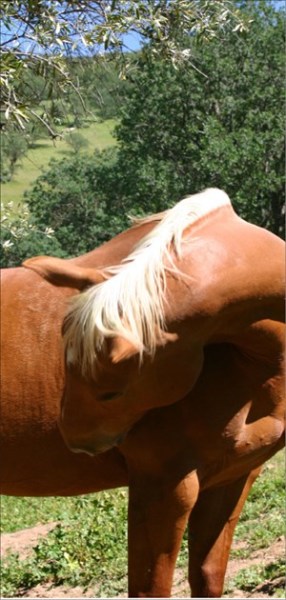
The problem was a mild allergic reaction to the new shampoo you’d used for your horse’s last bath. You get rid of that bottle and go back to your horse’s old shampoo, and it never happens again.
It’s not always so simple. In some horses, allergic reactions are a chronic, frustrating and potentially debilitating part of life. They occur when, for reasons that are not fully understood, a horse’s immune system becomes hypersensitized to substances, called allergens, that ordinarily do no harm. When that happens, the immune reaction runs out of control. An overabundance of antibodies are produced, which, in turn, stimulate the release of a flood of prostaglandins, histamines and other substances. Once a horse has had an allergic reaction to a substance, each subsequent exposure tends to increase the severity of his body’s response.
Outwardly, the signs of all of this physiological activity are usually seen in the skin and respiratory system. An allergic reaction in the skin, called atopic dermatitis, usually causes itching (pruritus) and/or recurrent hives (urticaria). Other possible signs include patchy hair loss, bumps and crusting.
When allergies affect the respiratory system, the result is heaves, technically known as recurrent airway obstruction (RAO). Initially, heaves may produce nasal discharge, a mild cough and slight exercise intolerance, but as the condition advances, a horse usually coughs more frequently and deeply, and his breathing may be labored even when he is standing still.
Allergies are not common in horses, but when they do occur, early intervention can help keep a minor problem from becoming a significant health issue. That’s why it’s important to learn the most common causes of allergic reactions, the signs they produce and the most effective treatments.
TYPICAL TRIGGERS 1. Insect bites By far the most prevalent equine allergy is hypersensitivity to the saliva from insect bites. The most severe form of this allergy is sweet itch (also known as summer itch and equine insect hypersensitivity), a reaction to tiny biting midges (Culicoides spp.). But other biting insects—including mosquitoes,horseflies, deerflies, stable flies, blackflies and even mites and fleas—also trigger allergic reactions in horses.
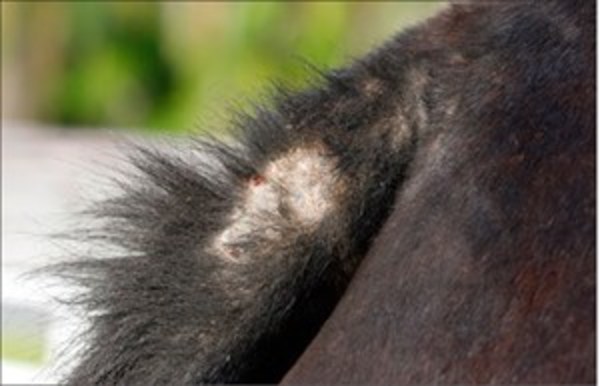
Signs: itchiness, which sometimes results in hairless patches and inflamed, scabby skin. The areas affected by skin allergies depend on which insects instigate the problem. Bites can occur almost anywhere on a horse’s body but are most often seen on the belly, root of the mane, base of the tail and face.
Risk factors: Individual sensitivity to insect saliva varies widely. When it comes to sweet itch, however, some breeds seem to be more susceptible.“The Welsh Ponies, Icelandic and Shire horses are more prone to this type of allergy,” says veterinary dermatologist Christine Rees, DVM, of Veterinary Specialists of North Texas in Dallas.
Best treatment strategy: Topical ointments may soothe the skin and reduce itchiness: “Things we recommend to decrease itching include topical steroids or a hydrocortisoneleave-on conditioner that you can apply to selected areas of the body to make the horse more comfortable,” says Rosanna Marsella, DVM, of the University of Florida. In some cases, antihistamines help.
In addition, says Rees, “You can try to desensitize the horse using allergy shots for an insect problem, but it seems like these shots work better if the horse also has pollen allergies. Getting aggressive with insect control/protection is probably the most beneficial for that horse.” Protecting a horse from biting insects requires a program that integrates several measures:
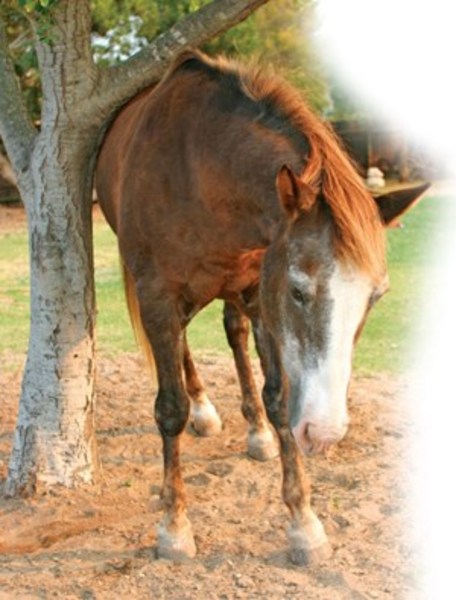
- Apply repellents and/or insecticides. Your choice of fly spray is significant if you have an allergic horse. Some products are insecticides—they kill the fly after it has bitten; others are repellents, which discourage the fly from landing in the first place. “If a horse has allergies, it’s not enough to kill the insect after it has bitten the horse. You need to prevent the bite,” says Marsella. “Many veterinarians recommend products with permethrin, but in order to be a repellent, it has to be at least 2 percent permethrin. Most [over-the counter] products have a lower percentage than that and therefore won’t work as repellents.”
- Adjust your turnout schedule. Stable your horse during the hours that the flies that bother him are most active. Some species fly only in broad daylight; others are a problem at dawn and dusk. If Culicoides are bothering your horse, stable him at dawn and dusk and install fine-mesh screens to keep these insects out of the barn. In addition, says Marsella, “If you have good fans and apply repellent, this will significantly cut down on your horse’s insect exposure.”
- Outfit your horse with fly-proof garments. Once you’ve determined the types of insects causing your horse’s problems, add the most appropriate accessories, such as ear nets, belly bands or tail covers, to your fly sheets. Some insects attack a horse’s ears or face; others go for the belly or legs.
2. Airborne agents Just like people, horses can develop sensitivities to molds, dust, pollens and other airborne allergens.

Signs: Environmental allergies stimulate either respiratory or skin reactions. Most horses experience one or the other, but not both at once. Skin reactions usually appear on the face, legs and body and may or may not be itchy. The signs may be seasonal or persist year-round. Respiratory allergies tend to produce nasal drainage, a cough and labored breathing. Other nonspecific signs of environmental sensitivity include runny eyes, general malaise and headshaking.
Risk factors: Horses already sensitized to one allergen may be more apt to develop new allergies to others. Heaves is more likely to appear in horses older than 9 years.
Best treatment strategy: It’s impossible to eliminate most environmental allergens from a horse’s life, but you can take steps to minimize his exposure to them. Skin tests can be invaluable in this process, says Rees. “If a horse has a history of seasonal problems at certain times of year, I recommend a skin test to figure out what’s causing it,” she says. For this procedure the horse is taken to a university clinic, where he is sedated and a large patch of hair is shaved from his neck. Then 50 to 60 different allergens (everything from molds, airborne allergens and grasses to insect saliva/venom) are injected in tiny amounts, using a grid pattern and a key to indicate where each allergen is injected. The grid is then examined 15 minutes, 30 minutes, four to six hours and then 24 hours later for signs that one or more of the allergens have produced an allergic response.
Skin tests generally cost from $300 to $400, but the investment is well worth it if the results pinpoint the source of a horse’s problem so that a targeted treatment can be adopted. “You might be able to use allergy vaccines in these horses and get them off medications or inhalers by building up the body’s own defenses,” explains Rees. Serum allergy tests are also available but are not very useful compared to skin testing.
Management strategies for horses with RAO generally mean keeping them away from the environment that aggravates the condition. For barn associated RAO, that means turning a horse out as much as possible, offering only clean hay that is free of dusts and molds, and feeding from the ground so that inhaled particles will drop downward rather than get drawn deeper into the airways. Soaking hay prior to feeding will also minimize dust. If a horse’s respiratory allergies are aggravated by the pollens of summer pastures, he will benefit from being kept in a well-ventilated barn during the peak season.
For allergic reactions limited to only a few areas of the skin, topical remedies are often useful. “One product I prescribe is topical tacrolimus [Protopic],” says Marsella. “This is a human ointment for atopic eczema. You can use it for spot treatment on areas that are itchy, such as on horses who rub their ears, legs, face or skin above the eyes. If you don’t want to use a spray, you can use this ointment once a day to decrease inflammation and itching, and the effect is quite rapid.”
3. Contact
Almost anything you put on a horse, from shampoos to fly sprays or even your saddle pads and wraps, has the potential to trigger allergic skin reactions.
Signs: Contact allergies produce signs typical of atopic dermatitis, but the distinguishing factor is that the lesions appear only on or near the area of the body where the allergen was applied.
Risk factors: A horse is more likely to develop contact allergies if his close relatives are also hypersensitive.
Best treatment strategy: The most basic solution for contact allergies is to identify the source of the reaction and stop using it on your horse. Grooming products and even fly sprays are common culprits. Once you’ve identified the source of the problem, check the label and shop for a substitute with different active ingredients. Hypoallergenic products, and those formulated for horses with sensitive skin, are available in many categories. Ask your veterinarian for recommendations if your horse’s problem persists with multiple products.
As a preventive measure, make it a practice to try any new product on only a small portion of the horse’s body first. If the skin there still looks normal after 24 hours, then the product ought to be safe to use anywhere on your horse.
Sometimes it’s necessary to look a little harder to find the source of the allergy, which can come from unexpected places. “I had one horse that developed dermatitis over the back, in the area of the saddle pad, from a neoprene pad,” Rees says. Horses can also have allergies to wool or the lanolin in wool. “Wool blankets or pads may cause problems,” Rees says. “Lanolin is also present in some topical sprays and shampoos. Some horses that have wool allergies are allergic to the lanolin in topical products also. If your horse is sensitive to wool, read labels.”
Some bits have rubber mouthpieces that can cause reactions. “It may be the color dye in the mouthpiece,” says Rees. “Leg wraps and bandages may also contain material a horse might be sensitive to. Usually it’s something put next to or on the skin—some sort of material or cover, or a spray or lotion.”
Corticosteroids and/or antihistamines may help keep a horse comfortable until the signs subside.
4. Food allergies It doesn’t happen often, but horses can develop sensitivities to natural foods—grasses or grains—as well as additives in processed feeds or supplements.
Signs: The primary sign of a food allergy is hives, with or without itching, that cover the body. Other signs of atopic dermatitis may also be present. Food allergies are usually nonseasonal, but not always—if the horse is allergic to a plant that grows only in the summertime or a hay fed only in winter, for example.
Risk factors: None are known.
Best treatment strategy: Once the source of the allergy has been identified, eliminate that product or forage from the horse’s diet. No other treatments are effective. The most common triggers are preservatives in feeds.
Eliminating legumes usually requires more care than just switching hays. “Often people don’t think about all the products that contain alfalfa,” says Rees. “They may be feeding Strongid-C dewormer, for instance. Many types of pelleted products contain alfalfa. Some medicines or treats have alfalfa in them if they are cubed or pelleted.”
Allergies to oats or grass hays aren’t common but need to be considered as well. Rees once encountered a horse who was allergic to coastal hay: “We ended up feeding timothy hay, which was the only thing he didn’t react to.”
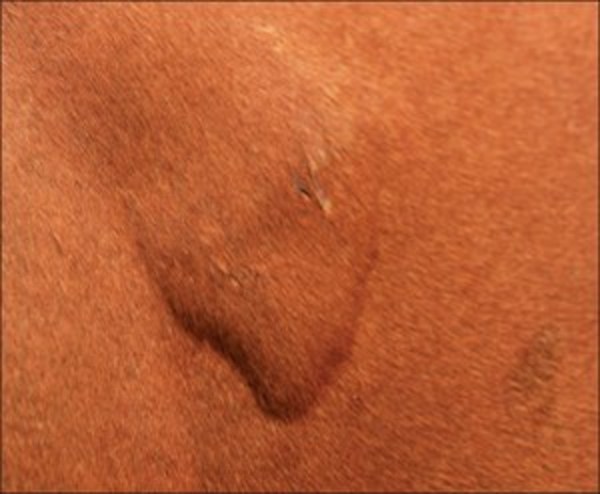
5. Medications, dewormers and vaccines True allergic reactions to drugs or vaccines are rare, but in a few cases the consequences can be fatal.
Signs: Usually, an allergic horse will experience localized swelling at the injection site and possibly an outbreak of hives all over the body. In rare cases, however, a horse may develop anaphylaxis, a systemic shock reaction. This generally occurs suddenly, shortly after the administration of the medication or agent, and the horse may collapse and die without immediate veterinary treatment. True “penicillin” reactions often result in immediate death. This is very rare. More commonly, a horse has a“procaine” reaction to intramuscular procaine penicillin because some of the procaine ended up in a blood vessel. This causes the horse to react uncontrollably—gallop, spin in circles, climb the walls of a stall. It is very frightening but is over in about a minute. There is nothing you can do except get completely out of the way to ensure your own safety. Procaine reactions are not allergic reactions, and these horses are no more likely to have a second procaine reaction than any other horse.
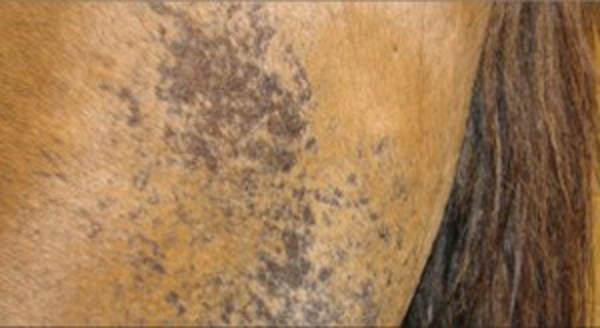
Risk factors: A horse who has had an allergic reaction to a certain drug or vaccine in the past may have a more severe reaction the next time.
Best treatment strategy: Discuss any concerns with your veterinarian. If a horse reacts to a vaccine, he may be hypersensitive to the product’s adjuvant, the ingredient that stimulates an enhanced response from the immune system. “Some vaccines don’t have an adjuvant and therefore produce fewer reactions,” says Allison Stewart, BVSc, DACVIM, DACVECC, of Auburn University. “If you have a horse that reacts to vaccines, talk to your veterinarian and find some that have no adjuvants.”

If your horse has reacted to a particular vaccine in the past, avoid combo products that include it. You don’t always know which portion is the problem. “Often it’s the rabies that seems to be the culprit. Some of the vaccine companies are working on new rabies vaccines that hopefully will be a little less reactive,” says Stewart. Administering antihistamines and/or anti-inflammatory medications along with the vaccine may also reduce the severity of an allergic reaction.
Even more rare are allergic reactions to drugs, such as penicillin or bute, or dewormers. “If your horse suddenly develops a horrible skin condition, it’s important to consider if he was just treated with a drug,” says Stewart. “The best treatment may be to stop using that drug.”
Researchers are only just beginning to understand how equine allergies work and how they differ from those occurring in other species. “There is tremendous need for more information and identifying new treatments to make these animals more comfortable,” says Marsella. The hope is that someday even the severest equine allergy will be fully treatable, and scourges like sweet itch and even heaves may become a part of the past.








